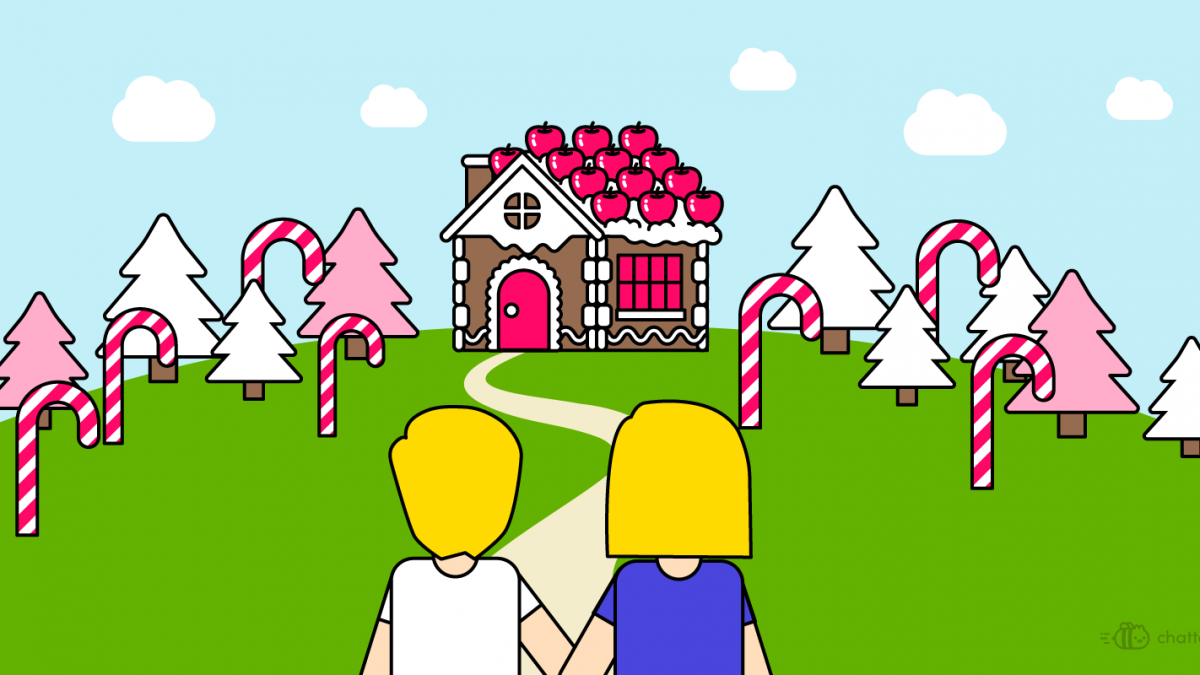7 Children’s Stories to Help You Learn German
When learning a language as an adult, more often than not you’ll use age appropriate content to learn it. Maybe you watch the news, read short stories or listen to podcasts. But have you ever tried to learn a language through children’s stories? If you’re learning German, you’re in luck. You may already be familiar with some of these stories, and their German origin might be obvious (Hansel and Gretel, Rapunzel, Rumpelstizchen) but others may surprise you! So indulge in these fantastical, mystical and sometimes sinister stories, and learn some German along the way!
The most famous of these children’s stories are, of course, the fairy tales written by Jacob and Wilhelm Grimm, known as the Brothers Grimm. Their collection was originally titled Kinder- und Hausmärchen (Children’s and Household Tales), now known simply as Grimms’ Fairy Tales. The first collection of 86 stories was written by the Grimm brothers in 1812, and the second collection of 70 stories was published three years later. Between 1837 and 1857, seven more editions were published. The final edition contained 210 stories. If you’re a fan of fairy tales, you won’t be short for choice! We’ve picked out some of our favourites for you to learn German with.
Snow White (Schneewittchen)
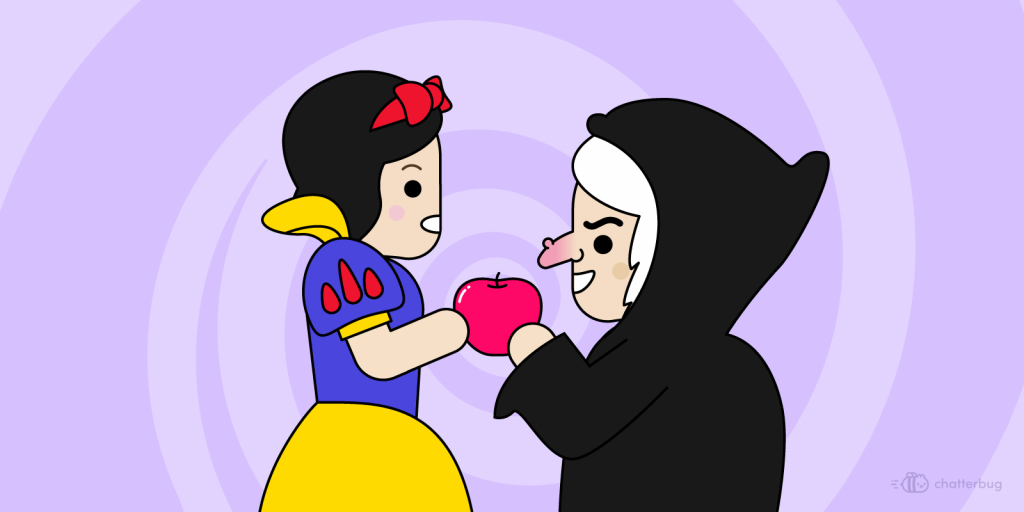
While you might be familiar with the silky-voiced, saucer-eyed Disney versions of some of the female characters on this list, their stories are of German origin. The Grimm Brothers’ tale of Snow White is a little different to Disney’s Snow White and the Seven Dwarves. It starts with a Queen, who is also Snow White’s wicked step-mother, being betrayed by her magic mirror. She is informed that she is not, in fact, the fairest of them all (brutal), but has been surpassed in stunning good-looks by her seven-year-old step-daughter, Snow White herself. Loose cannon that she is, the Queen decides Snow White should be killed. Unfortunately for the vain Queen, the hitmen she hired refrain from removing Snow White’s heart (as per the Queen’s request) after she begs them not to, bringing back a pig’s heart to instead to cover their tracks.
Young Snow White is taken in by seven dwarfs (unlike the Disney version, these ones don’t sing or have names, and each is aged over 100 years old…). Snow White lives peacefully with the Dwarfs for ten years until the magic mirror blows her cover, sending the blood-thirsty Queen her way in a variety of disguises, making three unsuccessful attempts to kill Snow White. The closest Snow White gets to dying is after she is convinced by the Queen to eat a poisoned apple, which sends her into a sleep from which the Dwarves cannot wake her.
Luckily, this is a fairy tale, which guarantees that at some point a prince will come and save the day. And save the day he does! Not only does he accidentally dislodge the poison apple from her throat by dropping the glass coffin the Dwarfs put her in, but he also weds her and subjects the evil Queen to death by dancing (in red hot shoes).
Cinderella (Aschenputtel)
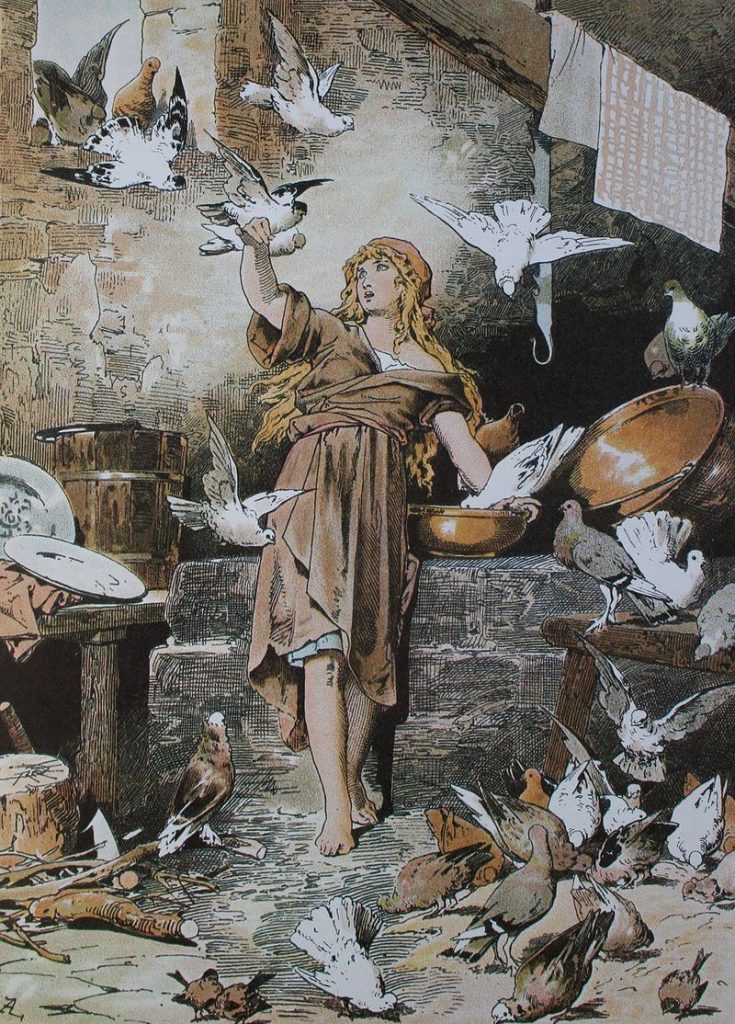
Cinderella features in the Brothers Grimm collection, although its original story is thought to be the story of Rhodopis, first recorded by Strabo, a Greek historian, in around the late 1st century BC. The first European version of this story was published by Italian writer Giambattista Basile in 1634, and the version familiar to most is by Charles Perrault, a French writer who published his version in 1697. The Grimm’s version, unsurprisingly, is arguably the darkest.
The story begins with the death of Cinderella’s mother. Her father soon remarries, and his new wife has two daughters. Unfortunately for Cinderella, her new step-family is very cruel to her. But things turn around when a magic hazel-tree grows on top of her mother’s grave, and with it two magic doves, who grant all of Cinderella’s wishes. This stroke of luck coincides with the local Prince’s quest for a wife. Cinderella asks the magic doves for some fancy dresses, and secretly spends a few days dancing with the Prince, although she refuses to reveal her identity. Eventually he works out where she lives and shows up armed with a slipper she left behind, demanding to know whose foot fits the shoe. Reveal yourself, future wife!
Characteristically, the evil step-sisters mutilate their own feet in a bid to become a princess. The magic doves have Cinderella’s back though, and tell the prince of their bloody, toeless feet. He manages to get Cinderella to try on the shoe and, what do you know? It fits! The first edition ended there, with Cinderella being swept away by the Prince.
In the 1819 second edition, Cinderella has her revenge on her step-sisters by instructing the magic doves to peck the sisters’ eyes out during the wedding ceremony, rendering them blind as well as unable to walk on their mutilated feet. Not quite the Disney ending we’re familiar with!
Little Red Riding Hood (Rotkäppchen)
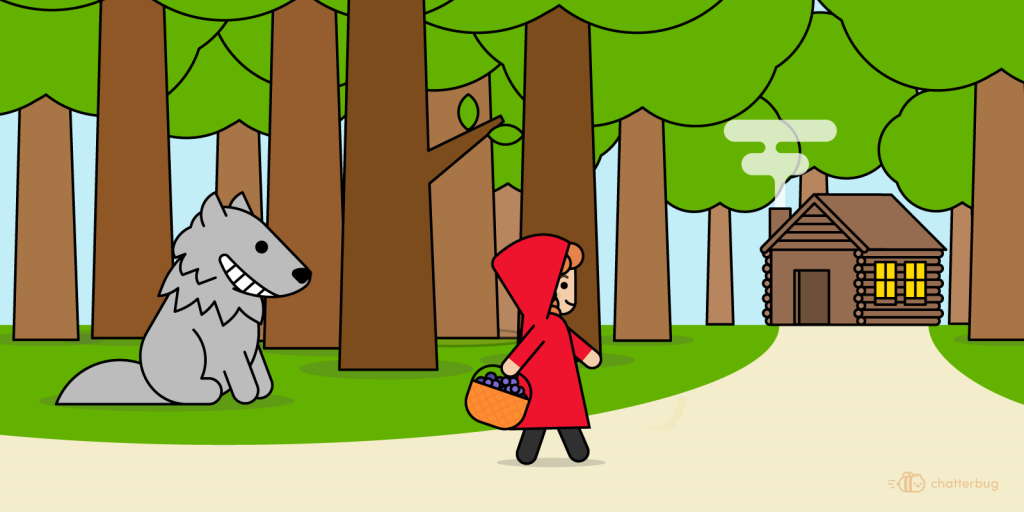
Little Red Riding Hood visits her sick grandmother every day, bringing her cake and wine. Her mother tells her to stick to the path. Little does she know, a greedy wolf is watching her every move, and wants to eat her for lunch. He tricks her into picking flowers, and while she does, he goes to the grandmother’s house, eats her whole, and dons her clothes to pose as the grandmother when Little Red Riding Hood arrives. We can only assume Red Riding Hood needed glasses, for while she queries the size of her ‘grandmother’s’ big eyes, hands, mouth and deep voice, she doesn’t notice that her grandmother is actually a wolf in a dress. Clearly she is easily out-smarted, and the wolf eats her whole, too.
He then takes a nap. Luckily in the Grimms’ version, a woodcutter comes to the rescue and cuts open the wolf’s belly, freeing Red Riding Hood and her grandmother, and fills the wolf’s body with rocks. When the wolf wakes up later, he goes to take a drink from the well, but his body is so heavy with rocks that he falls in.
Sleeping Beauty (Dornröschen)
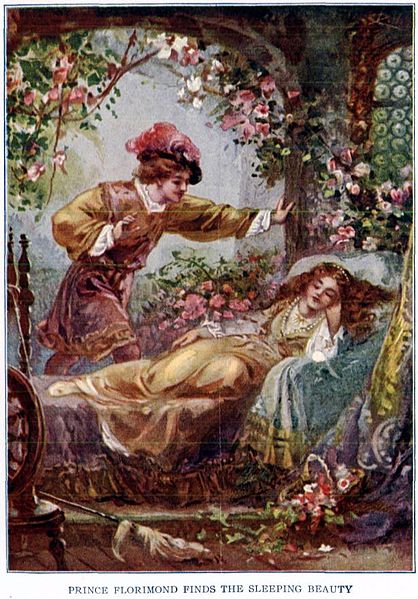
The story of Little Briar Rose (or Sleeping Beauty) begins with a royal family being told by a wicked fairy, slighted after being overseen by the monarchy, that one day their daughter will prick her finger on a spindle and this will kill her. A kind fairy tries to overturn this curse, but only manages to replace death with sleep. The family empty their kingdom of spindles but to no avail. When her parents are out, the princess finds an old woman using a spindle, asks if she can learn to use it, and soon after is taken by the curse. However, rather than dying, the princess falls into a deep sleep.
Everyone in the kingdom was also put to sleep. The castle and grounds are surrounded by trees and rose bushes which grow taller over the years, preventing anyone from entering the kingdom. But what do you know, a prince managed it. A hundred years after she’d fallen asleep, Little Briar Rose is awoken by a prince’s kiss. Instead of being terrified, as you’d think she might be, she was happy to see this stranger in her room. The rest of the palace woke up too, and Briar Rose and the prince married and lived – yep – happily ever after.
Rapunzel
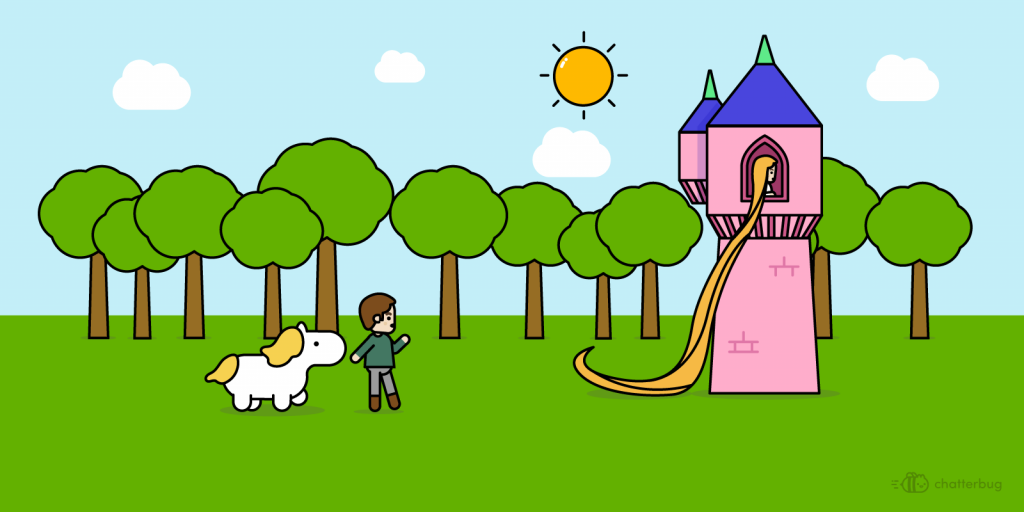
Rapunzel gets her namesake from the salad green, Rapunzel, because that is what her mother craved during her pregnancy. In fact, her pregnancy cravings were so strong that they almost ruined Rapunzel’s life. While his wife was pregnant, Rapunzel’s father broke into his next door neighbour’s garden to steal her rapunzel. What are the chances that a witch lives next door? Upon finding him, the witch wasn’t best pleased and agreed to let him go on the condition that she could have his first-born. When the witch is given Rapunzel, she locks her in a tower, and the only way of reaching the top of it is to climb Rapunzel’s long, and presumably incredibly strong, golden hair. Ouch.
Fast forward to a prince hearing Rapunzel singing from her tower and becoming enchanted. He then sees the witch climbing her hair and gets ideas. Once he convinces Rapunzel to let him climb her hair to the tower, they fall in love and he proposes. They hatch a plan for Rapunzel to weave a ladder out of some silk that he’s brought her.
In the first edition, she says her dress is getting tight around her waist, suggesting she is pregnant. In later editions she forgetfully asks the witch why it’s easier to haul up the prince than her. Enraged, the witch cuts off her hair and throws her out the window. When the prince shows up later, the witch lets down Rapunzel’s severed hair for him to climb. He’s horrified when he sees her, and then blinded by thorns from the rose bush he falls into. Luckily, years later, he happens upon Rapunzel and the twins she had in the meantime. They embrace, and her tears restore his vision.
Rumpelstiltskin (Rumpelstilzchen)
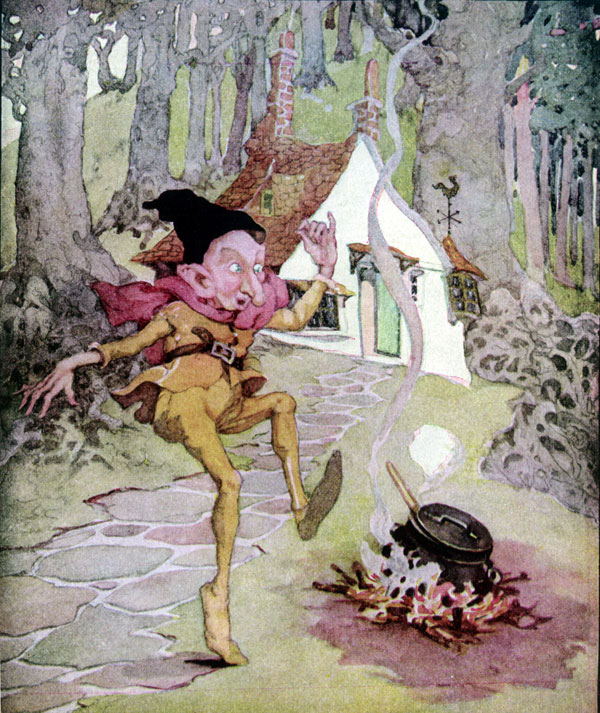
The story begins with a miller telling the King his daughter can spin straw into gold. Impressed, the gullible King calls for the girl and locks her in a tower room filled with straw. By a stroke of good luck, an imp-like creature shows up and offers to do her task for her if he can have her necklace. This goes on for the next three nights, with the girl exchanging her ring on the second night, and on the third the promise that he takes her first-born. The King, so impressed by the girl’s gold spinning abilities, marries her.
When she has her first baby, the imp shows up to claim his reward. She begs to keep her baby, offering him all the wealth she has, but the imp is only interested in her child. Eventually he agrees to give up on their deal if she can guess his name within three days.
Luck falls upon this straw-spinning princess. After trying and failing to guess his name (did you read the title?!), she takes herself on a walk to clear her head. As if by fate, she walks past his house and hears him gloating. He says ‘Ach wie gut, dass niemand weiß, dass ich Rumpelstilzchen heiß’, which translates to ‘Ah how good that no one knows that my name is Rumpelstilzchen.’
The original ending concludes with the imp running away and never coming back. The second edition’s more revolting ending sees the imp tear himself in half with rage. Rumpelstiltsgrim, am I right?
Hansel and Gretel (Hänsel und Gretel)
Set in medieval Germany, Hansel and Gretel are the children of a very poor woodcutter. As seems typical in German fairy tales, their family unit includes an evil step-mother. On account of their dire financial situation and her evil ways, the step-mother convinces the father to leave the children in the woods to fend for themselves. Luckily, Hansel and Gretel overhear the adults hatching this plan, and make one of their own. During their big walk into the woods the next day, the children lay white pebbles so that they may find their way back. The step-mother is furious and tries again the next day. During this walk, Hansel leaves a trail of breadcrumbs. Unfortunately for the crafty kids, birds consume their trail.
Lost in the woods, they stumble upon a gingerbread house, owned by a witch who lures them inside to eat them. Luckily, the children outsmart her and she burns to ashes in her giant oven. The children take all her jewels and travel home, where they find their father widowed. The three live happily ever after.

Want to learn more?
If you’re feeling inspired to learn German, sign up below for a free two week-trial and a Live Lesson with a private qualified tutor to start speaking a new language for real! Our classes are structured around exercises created by language teachers, so there’ll be no awkward silences – we promise! 😉
